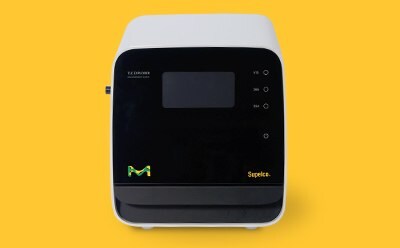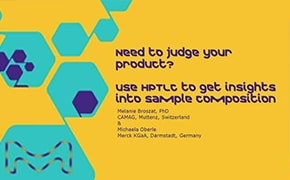Thin Layer Chromatography (TLC)

Thin layer chromatography (TLC) is a widely used separation technique for quantitative and qualitative analysis. It uses a thin layer of a stationary phase coated on a glass, plastic, or aluminum plate. A liquid solvent called the mobile phase carries the sample and separates it as it moves across the plate. It offers the advantages of simplicity, sensitivity, and rapid analysis over other separation techniques.
View featured products:
Related Product Resources
- Brochure: Thin-Layer Chromatography
TLC, HPTLC, TLC-MS, PLC and Accessories Consistency is our standard
- /VN/en/technical-documents/technical-article/analytical-chemistry/thin-layer-chromatography/tlc-silica-gel-60g-plates-with-gypsum
TLC plates, with silica gel, gypsum as binder, International Pharmacopoeia compliant, for identification of Atenolol and Chlorthalidone in tablets.
- Thin-Layer Chromatography Process
TLC separation relies on capillary forces to transport substances on a stationary phase after mobile phase transport.
- /deepweb/assets/sigmaaldrich/marketing/global/documents/334/007/tlc-explorer-brochure-br12711en-ms.pdf
Simplify TLC Analysis with Smart Technology

Classical TLC Plates
Our classical thin layer chromatography plates are silica plates. They have a smooth and dense silica gel 60 coating to ensure narrow chromatographic bands. Classical plates are also available as aluminum TLC plates, glass TLC plates, or plastic TLC plates in a variety of plate dimensions, including our multiformat plates, and with two types of fluorescent indicators for UV detection. In addition to unmodified silica TLC plates, we also offer specialty TLC plates, including:
- Modified silica gel TLC plates for better separation and as a pilot method for HPLC
- Aluminum oxide TLC plates for separation of neutral and basic compounds
- Cellulose TLC plates for the precise analysis of polar substances
- Kieselguhr and mixed layer plates for the separation of polar or moderately polar compounds
- Concentrating zone TLC plates for the application and resolution of large sample volumes
- GLP TLC plates with a unique laser code to aid in documentation and record keeping

HPTLC Plates
HPTLC plates provide decreased band diffusion and compact chromatographic zones or spots. HPTLC plates are available in various dimensions and backings, including our multiformat plates, and the option of two different fluorescent indicators. Our classic silica HPTLC plates enable fast and sensitive quantitative analysis of complex samples for both manual and instrumental use. We also offer a variety of specialty HPTLC plates, including:
- Modified silica HPTLC plates for challenging separations
- Cellulose HPTLC plates for hydrophilic and polar substance separation
- LiChrospher® HPTLC plates optimized for fast, high-throughput separations
- Premium purity HPTLC plates for contamination-free separations and minimal background
- ProteoChrom® HPTLC plates for the analysis of peptides and protein digests
- Concentrating zone HPTLC plates for the application and resolution of large sample volumes
- GLP HPTLC plates with a unique laser code to aid in documentation and record keeping

MS-Grade TLC and HPTLC plates
Our MS-Grade plates enable direct mass spectrometric analysis of separated and dried samples on TLC and HPTLC plates. After chromatographic separation, our MS-Grade TLC plates can be used in either elution-based or desorption-based TLC-MS. MS-Grade plates are available either with or without fluorescent indicators and provide:
- Trace analysis in the nanogram range
- Low background signal and exceptional sensitivity
- Equal performance a standard TLC and HPTLC plates

Preparative TLC (PLC) plates
Preparative TLC plates are used for the analytical separation of large samples. Samples are typically loaded as a wide band rather than a spot and analyzed by UV-detection. Once resolved, sample bands are commonly recovered from the plate by scraping the adsorbent from the plate and eluting with a strong solvent
- Available in both the modified and unmodified type of coating.
- 0.5 mm - 2 mm range of coating thickness
- Available with or without fluorescent indicators

TLC Adsorbents
Our standardized TLC adsorbents are suitable for different TLC and PLC applications while providing reliable analytical results. We offer an extensive range of TLC adsorbents including:
- Different types of sorbent material such as silica gel 60, aluminum oxide, or cellulose
- Various grades and particle sizes
- With or without binder material
- With or without the fluorescent indicators
TLC Explorer Documentation System
Simplify TLC analysis with the TLC Explorer. Trust in the precision of digital imaging and automated spot detection for reliable quantitative analysis and consistent data interpretation.
- Simultaneous detection and measurement of TLC, HPTLC, and PLC plates
- Quick picture caption in less than 2 minutes with automated crop & rotation function
- Illuminates chromatogram from above in direct-light mode under 3 LED settings: 254 nm, 365 nm, and visible light, with automatic correction of background signals and inhomogeneous illumination
- Equipped with automated track recognition and retention factor (Rf) calculation, as well as solvent front and baseline detection. Adjustments can be made manually.
- Uses video densitometric measurement for reliable TLC quantification
To continue reading please sign in or create an account.
Don't Have An Account?

